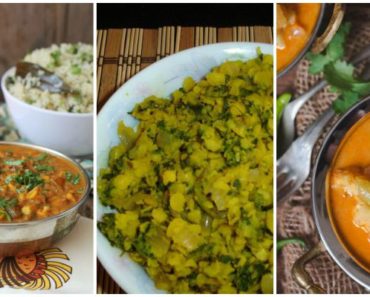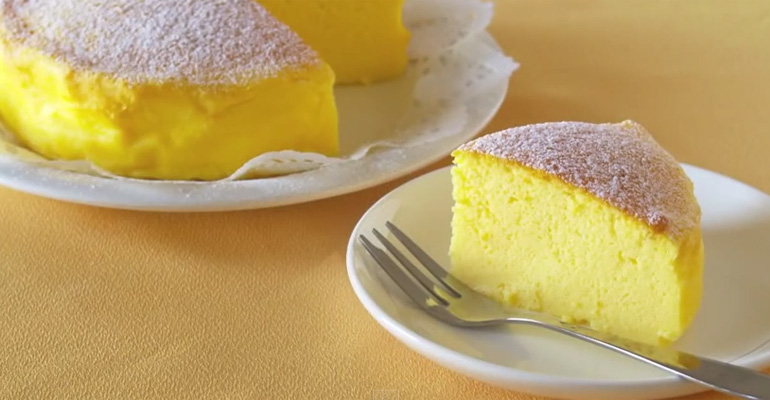- 1.8Kshares
- Share on Facebook
- Share on Twitter
- Pin on Pinterest
There are 2 kinds of people. Those that love spending time in the kitchen and those that don’t. If you love spending time baking and cooking, learning helpful kitchen and cooking tips to make cooking easier always helps.
Whether it’s simple things like learning how to boil an egg perfectly or more complex things like planning how much food to prepare for the perfect dinner party, these 15 kitchen tips and cheat sheets are sure to make cooking easier AND more fun.
1) Learn how to make easy 3 ingredient roasted chicken dinners with these kitchen tips.
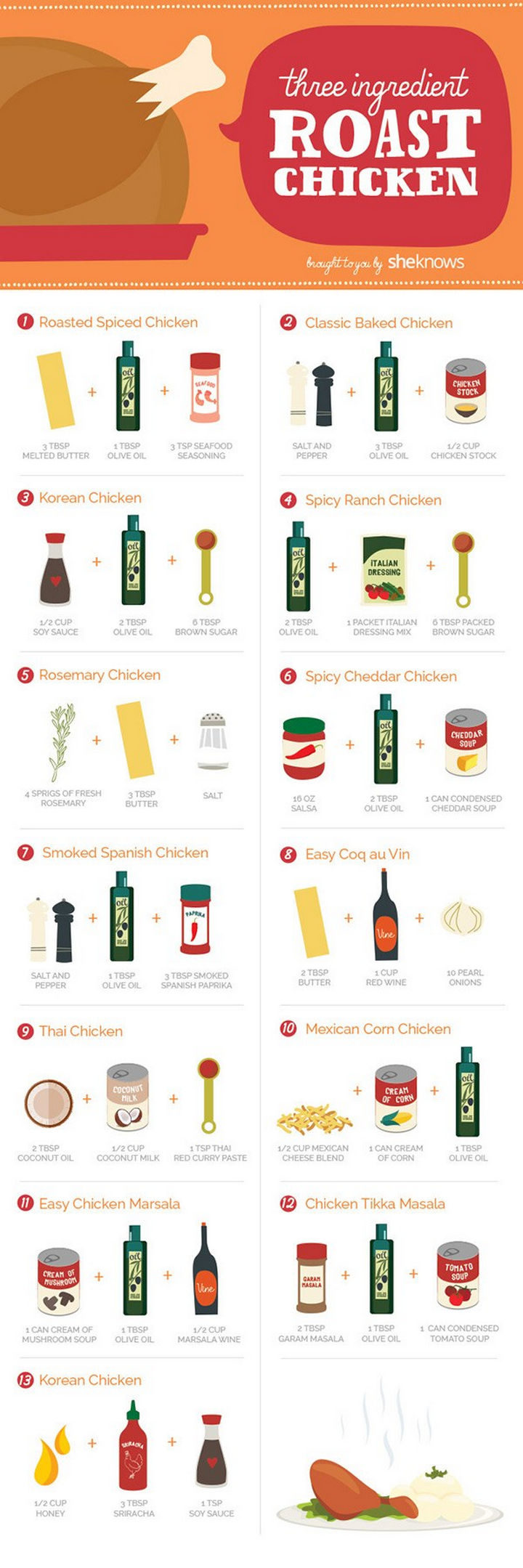
- Roasted Spiced Chicken: 3 Tbsp melted butter, 1 Tbsp olive oil, and 3 tsp seafood seasoning.
- Classic Baked Chicken: Salt and pepper to taste, 3 Tbsp olive oil, and 1/2 cup chicken stock.
- Korean Chicken: 1/2 cup soy sauce, 2 Tbsp olive oil, and 6 Tbsp brown sugar.
- Spicy Ranch Chicken: 1 Tbsp olive oil, 1 packet Italian dressing mix, and 6 Tbsp packed brown sugar.
- Rosemary Chicken: 4 sprigs of fresh rosemary, 3 Tbsp butter, and salt to taste.
- Spicy Cheddar Chicken: 16-ounce jar of salsa, 2 Tbsp olive oil, 1 can condensed cheddar soup.
- Smoked Spanish Chicken: Salt and pepper to taste, 1 Tbsp olive oil, 3 Tbsp smoked Spanish paprika.
- Easy Coq au Vin: 2 Tbsp butter, 1 cup red wine, and 10 pearl onions.
- Thai Chicken: 2 Tbsp coconut oil, 1/2 coconut milk, and 1 tsp Thai red curry paste.
- Mexican Corn Chicken: 1/2 cup Mexican cheese blend, 1 can cream of corn, 1 Tbsp olive oil.
- Easy Chicken Marsala: 1 can cream of mushroom soup, 1 Tbsp olive oil, 1/2 cup Marsala wine.
- Chicken Tikka Masala: 2 Tbsp garam masala, 1 Tbsp olive oil, 1 can condensed tomato soup.
- Korean Chicken: 1/2 cup honey, 3 Tbsp sriracha sauce, 1 tsp soy sauce.
Simply mix all 3 ingredients together and spread it over your roast chicken and rub it into the skin. Roast your chicken at 425 degrees Fahrenheit for 15 minutes then reduce the temperature to 375 degrees and continue to bake until chicken juices run clear and reaches a temperature of 165 degrees Fahrenheit.
2) How to make the perfect cheese plate with kitchen tips.
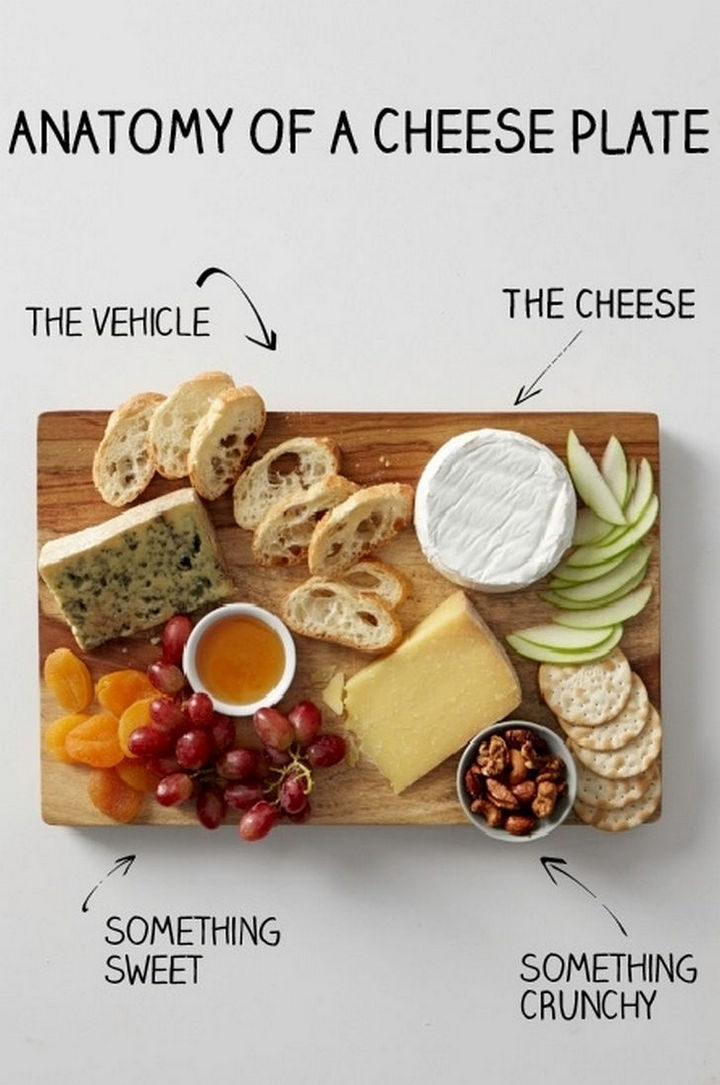
Every cheese plate should have something sweet, something crunchy, and of course one or more varieties of cheese. A variety of nuts and fruits such as grapes, apples or dried fruits like apricots or dates will provide the crunchy and sweet textures. You’ll generally need about a pound of cheese for every 5 guests. Aim to have at least 3 different types of cheese:
- Soft cheese such as mozzarella or goat cheese.
- Buttery soft cheese like Camembert or Brie.
- Semi-hard or hard cheeses like aged cheddar, Gruyere, or dry cheeses like Romano or Parmesan.
- A blue cheese is also a favorite.
Don’t forget to also add crusty bread and crackers!
3) Kitchen tips for how to select the best avocados.
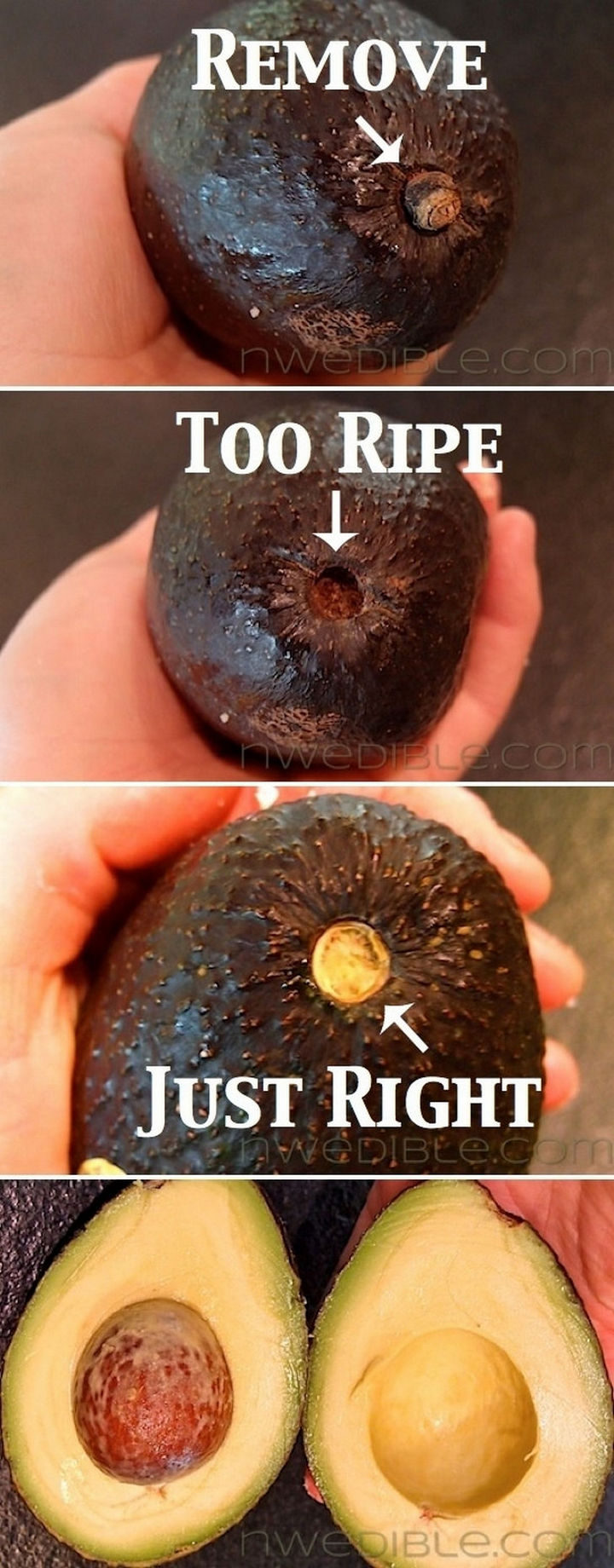
Remove the stem and choose an avocado with a pale color and avoid avocados that are darker under the stem.
4) Kitchen tips for how to make perfect hard boiled eggs.

Rolling boil method:
- Place eggs in a pan and add enough water to cover eggs with an inch of water over the top
- When water comes to a rolling boil, start your timer.
- Continue boiling eggs at high heat for 4 to 6 minutes.
- Remove eggs and place in ice bath.
Boiled for 2 minutes: Yolk still orange and wee bit gooey. Not done.
Boiled for 4 minutes: Yolk light yellow and soft with a gentle whip in the center. Done.
Boiled for 5 minutes: Still light yellow and sporting a cream center. Done Done.
Boiled for 6 minutes: Center less creamy, but yolk still semi-moist. End of done.
Boiled for 7 minutes or more: Gray edges begin and yolk is noticeably dryer. Overdone.
Time cooked method (My favorite method – perfect boiled eggs every time!)
- Place eggs in pot with room-temp water.
- Bring water to a boil them remove from heat.
- Cover and let rest for 10 minutes.
- Remove eggs and place in ice bath.
5) How to cook perfect vegetables every time.

Nobody likes soggy vegetables so here is how to cook them perfectly!
- Artichokes (whole): Boil for 30-60 minutes, steam for 25 to 40 minutes, or saute for 10 minutes.
- Asparagus: Boil for 10-15 minutes, steam for 8-10 minutes, or saute for 4-5 minutes.
- Beets: Boil for 30-60 minutes or steam for 40-60 minutes.
- Bok Choy: Boil stems for 4 minutes, add leaves and boil for an additional 3 minutes. If steaming, steam stems for 5 minutes, add leaves and steam for an additional 3 minutes. If sauteing, cook stems and leaves together for 6 minutes.
- Broccoli florets: Boil for 10-15 minutes, steam for 5-6 minutes, or saute for 3-4 minutes.
- Cabbage (shredded): Boil for 5-10 minutes, steam for 5-8 minutes, or saute for 3 minutes.
- Carrots (sliced): Boil for 5-10 minutes, steam for 4-5 minutes, or saute for 3-4 minutes.
- Corn on the cob: Boil for 5-8 minutes or steam for 4-7 minutes.
- Eggplant (sliced): Boil for 5-10 minutes, steam for 5-6 minutes or saute for 3-4 minutes.
- Green beans: Boil for 10-20 minutes, steam for 5-15 minutes, or saute for 3-4 minutes.
- Mushrooms: Boil for 3-4 minutes, steam for 4-5 minutes, or saute for 4-5 minutes.
- Peas: Boil for 8-12 minutes, steam for 3-5 minutes, or saute for 2-3 minutes.
- Bell Peppers: Boil for 4-5 minutes, steam for 2-4 minutes, or saute for 2-3 minutes.
- Potatoes (cut): Boil for 15-20 minutes or steam for 10-12 minutes.
- Spinach: Boil for 2-5 minutes, steam for 5-6 minutes, or saute for 3 minutes.
- Squash or Zucchini (sliced): Boil for 5-10 minutes, steam for 5-10 minutes, or saute for 3-4 minutes.
6) Kitchen tips for how to make the perfect burger.

Summertime brings out the hamburger eyes in everyone, when the promise of a blazing grill multiplies mild hunger into full-on famine. Everyone can agree on the basic ingredients – protein on a bun – but when it comes to dressing up a burger, no one way is superior to another. Fader’s menu matches condiments to personality, six seasonal delights for grillers and chillers.
Backyard Gourmand
Caramelize the onions over an open flame and savor the moment, letting their exquisite fragrance caress your olfaction. Anything less for your summer in the Hamptons is déclasse. Start with a beef patty, add a grilled portobello mushroom, swiss cheese, and serve with onions, tomatoes, pickles, lettuce, ketchup, and a sesame seed bun.
Vegan Stoner Special
No animals were harmed in the making of this burger, which will make the post-munchie slaughter of thie Vegan Stoner Special even sweeter. Lacing the whole wheat bun with weed tincture is optional. Start with a veggie burger patty, add lettuce, avocado, pickles, tomatoes, onions, sprouts, ketchup, and serve on a sesame seed bun.
Death Becomes You
Sweet and to the point, this is a meat orgy for the most carnivorous Dionysian griller. Condiments may contain vegetable byproducts, so sub in three types of cheese for flavor. Low-carb dieters: ditch the bun. Start with a grilled buffalo burger, add a beef burger, and serve with provolone cheese, Swiss cheese, American cheese, a fried egg, bacon, mayo, and a hearty bun.
Texas Style
Cooked rare. If your patty’s smaller than Gilbert Brown’s fist, you’re losing. Heart palpitation factor is high, but consumed in moderation you should be capable of lasting through the summer. Start with a grilled beef patty, add a fried egg, bacon, onion ring, BBQ sauce, and serve on a toasted bun.
American Graffiti ’84
There’s a reason it’s a classic: high schoolers on varsity football squads countrywide have kept mom and pop diners afloat with their voracious desier since at least the 1950s. But at some point during the Reagan administration, the country started frying everything – hence the onion ring, a recent addendum. Start with a 100% beef patty, and serve with American cheese, lettuce, onion ring, pickles, tomatoes, onions, mayo, ketchup, and top it all off with sesame seed bun.
West Coast Wannabe
Grab an Ed Hardy t-shirt, smother the sandwich in thousand-island dressing and pretend you’re living in Los Angeles for a second. If you actually live in Los Angeles, you reside in an oasis of burger establishments the rest of us would kill for. Why are you cooking?! Start with a grilled or fried beef patty, and serve with American cheese, lettuce, pickles, tomatoes, onions, thousand-island dressing, and a soft bun.
7) Learn these basic rules of etiquette at a formal table setting.
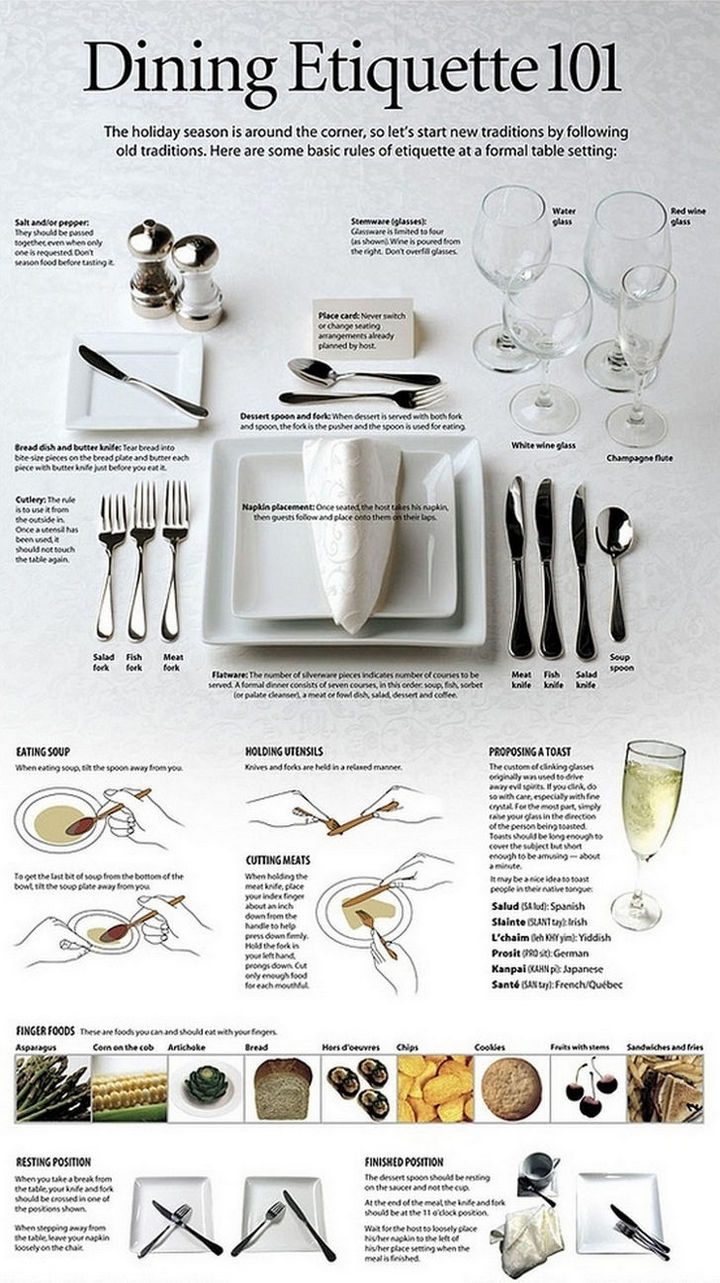
Dining Etiquette 101
Here are some basic rules of etiquette at a formal table setting:
- Salt and/or pepper: They should be passed together, even when only one is requested. Don’t season food before tasting it.
- Stemware (glasses): Glassware is limited to four (see above). Wine is poured from the right. Don’t overfill glasses.
- Bread dish and butter knife: Tear bread into bite-size pieces on the bread plate and butter each piece with butter knife just before you eat it.
- Flatware: The number of silverware pieces indicates number of courses to be served. A formal dinner consists of seven courses, in this order: soup, fish, sorbet (or palate cleanser), a meat or fowl dish, salad, dessert, and coffee.
- Cutlery: The rule is to use it from the outside in (see above). Once a utensil has been used, it should not touch the table again.
- Dessert spoon and fork: When dessert is served with both fork and spoon, the fork is the pusher and the spoon is used for eating.
- Napkin placement: Once seated, the host takes his/her napkin, then guests follow and place onto them on their laps.
- Place card: Never switch or change seating arrangements already planned by the host.
- Eating soup: When eating soup, tilt the spoon away from you. To get the last bit of soup from the bottom of the bowl, tilt the soup plate away from you.
- Holding utensils: Knives and forks are held in a relaxed manner.
- Cutting meats: When holding the meat knife, place your index finger about an inch down from the handle to help press down firmly. Hold the fork in your left hand, prongs down. Cut only enough food for each mouthful.
- Proposing a toast: The custom of clinking glasses originally was used to drive away evil spirits. If you clink, do so with care, especially with fine crystal. For the most part, simply raise your glass in the direction of the person being toasted. Toasts should be long enough to cover the subject but short enough to be amusing – about a minute.
- These are food you can and should eat with your fingers: Asparagus, corn on the cob, artichoke, bread, hors d’oeuvres, chips, cookies, fruits with stems, sandwiches, and fries.
- Resting position: When you take a break from the table, your knife and fork should be crossed in one of the positions shown (see above). When stepping away from the table, leave your napkin loosely on the chair.
- Finished position: The dessert spoon should be resting on the saucer and not the cup. At the end of the meal, the knife and fork should be at the 11 o’clock position. Wait for the host to loosely place his/her napkin to the left of his/her place when the meal is finished
8) Kitchen tips for how to test steak doneness by touch.
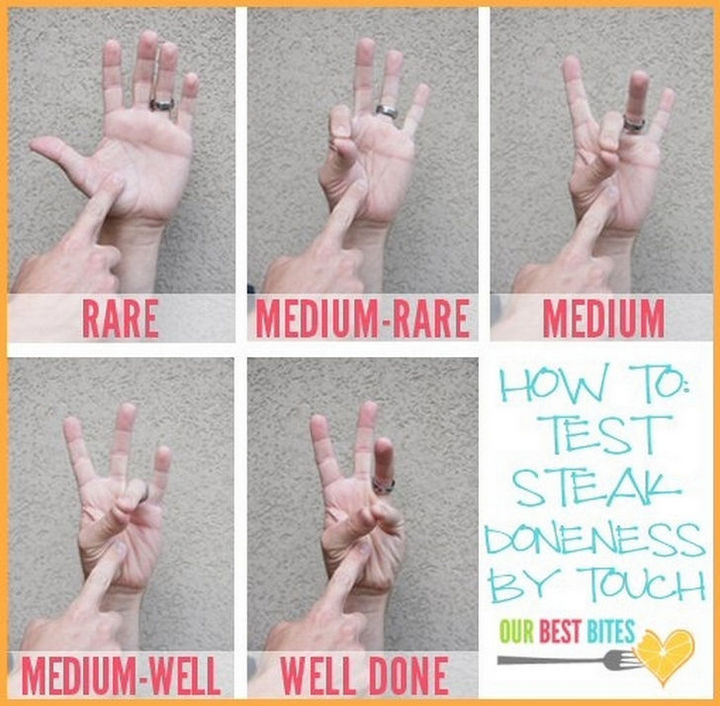
You can’t go wrong with a meat thermometer but after cooking steak many times, you’ll eventually learn to test steak doneness simply by touch.
9) How to choose the right beer glass depending on the brew.
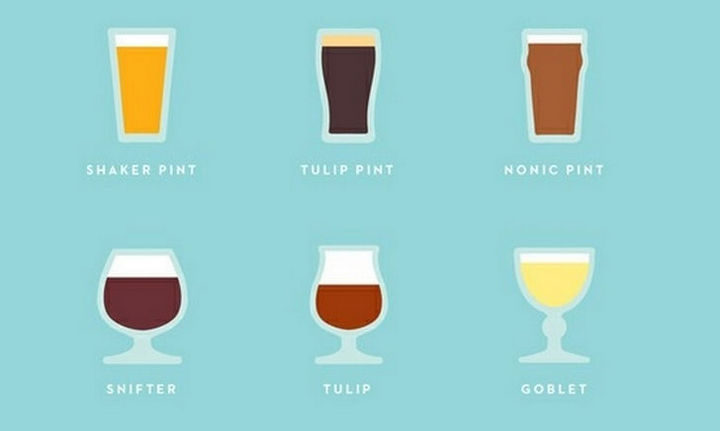
The color of your beer actually dictates what type of glass you should drink it in:
- Shaker pint: Ideal for most ales but not the best glass as the straight sides and large mouth means beer will get flat and warm fast.
- Tulip pint: A classic glass for Guinness or other dark dry stouts.
- Nonic pint: Fine for most ales and glass features a bump which acts as a fill line to help achieve a perfect 1-inch head.
- Snifter: Great for barleywines and big stouts, the snifter has a small mouth to help concentrate the aroma.
- Tulip: Like the snifter, the tiny mouth of the tulip helps bring out the aromatics in beers such as Scotch ales or Belgian beers.
- Goblet: The stem helps you grip the beer without making it warm but like the shaker pint, the wide mouth makes beer go flat a little faster.
10) How much food to prepare and serve at a party with these kitchen tips.
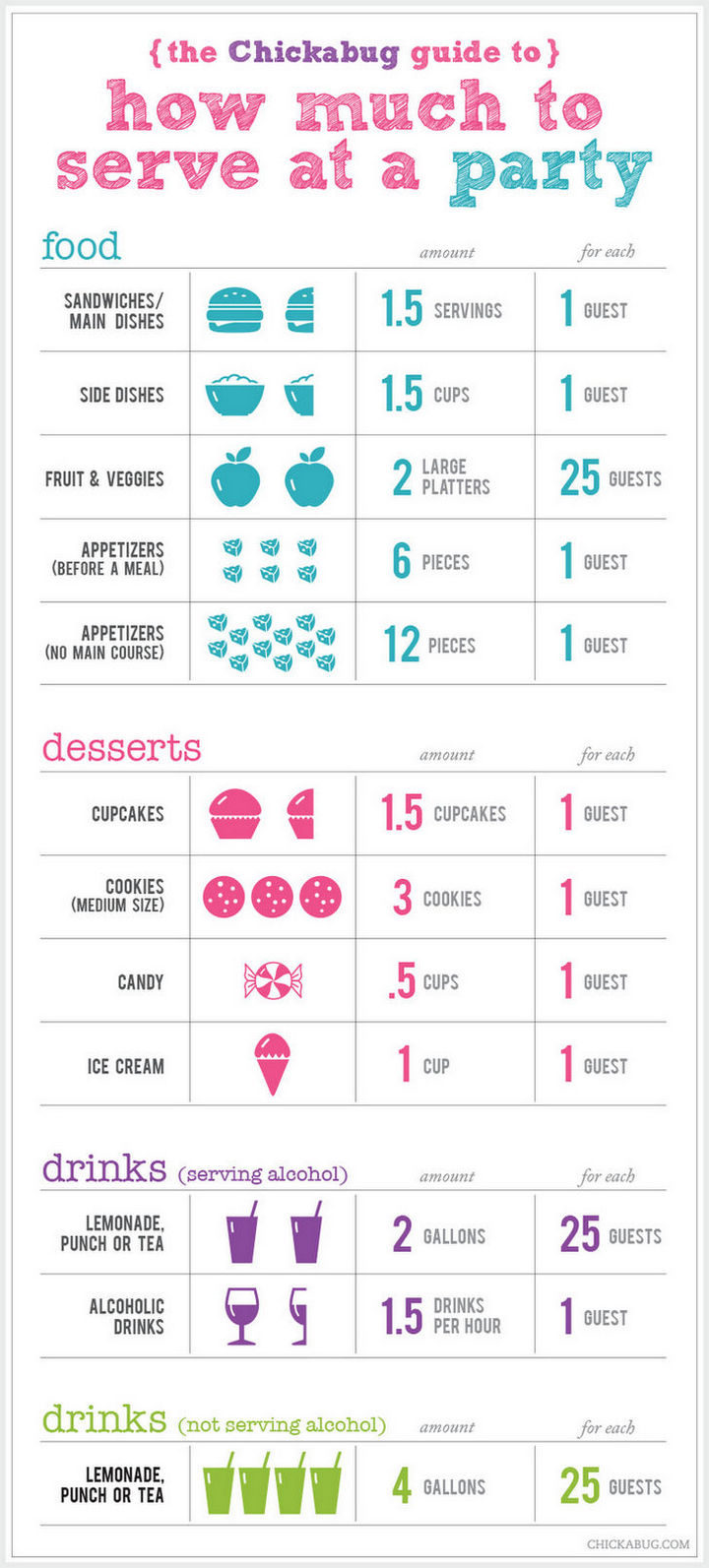
How much food to serve at a party:
- Sandwiches/main dish: 1 1/2 servings per guest.
- Side dishes: 1 1/2 cups per guest.
- Fruits and veggies: 2 large platters per 25 guests.
- Appetizers (before a meal): 6 pieces per guest.
- Appetizers (no main course): 12 pieces per guest.
How many desserts to serve at a party:
- Cupcakes: 1 1/2 cupcakes per guest.
- Cookies (medium size): 3 cookies per guest.
- Candy: 1/2 cup per guest.
- Ice cream: 1 cup per guest.
How many drinks to serve at a party (if serving alcohol):
- Lemonade, punch, or tea: 2 gallons per 25 guests.
- Alcoholic drinks: 1 1/2 drinks per hour per guest.
How many drinks to serve at a party (if not serving alcohol):
- Lemonade, punch, or tea: 4 gallons per 25 guests.
11) How to brew the perfect cup of tea.
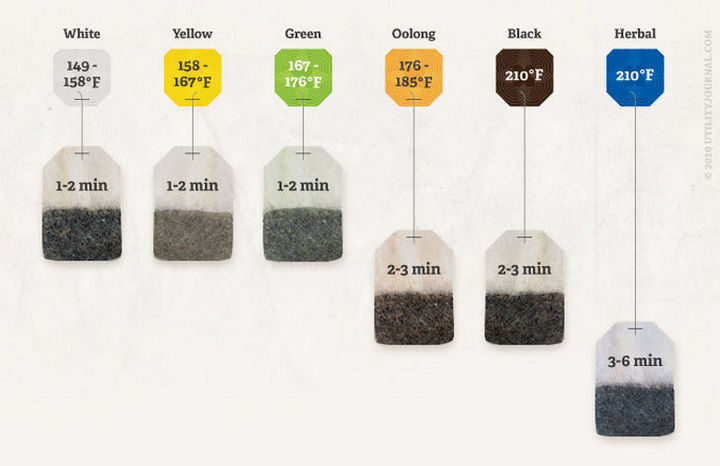
Optimal water temperature and steep time for the perfect cup of tea:
- White tea should be brewed for 1-2 minutes at a water temperature between 149-158 degrees Fahrenheit.
- Yellow tea should be brewed for 1-2 minutes at a water temperature between 158-167 degrees Fahrenheit.
- Green tea should be brewed for 1-2 minutes at a water temperature between 158-176 degrees Fahrenheit.
- Oolong tea should be brewed for 2-3 minutes at a water temperature between 176-185 degrees Fahrenheit.
- Black tea should be brewed for 2-3 minutes at a water temperature of 210 degrees Fahrenheit.
- Herbal tea should be brewed for 3-6 minutes at a water temperature of 210 degrees Fahrenheit.
12) Kitchen tips for how to convert common kitchen measures.
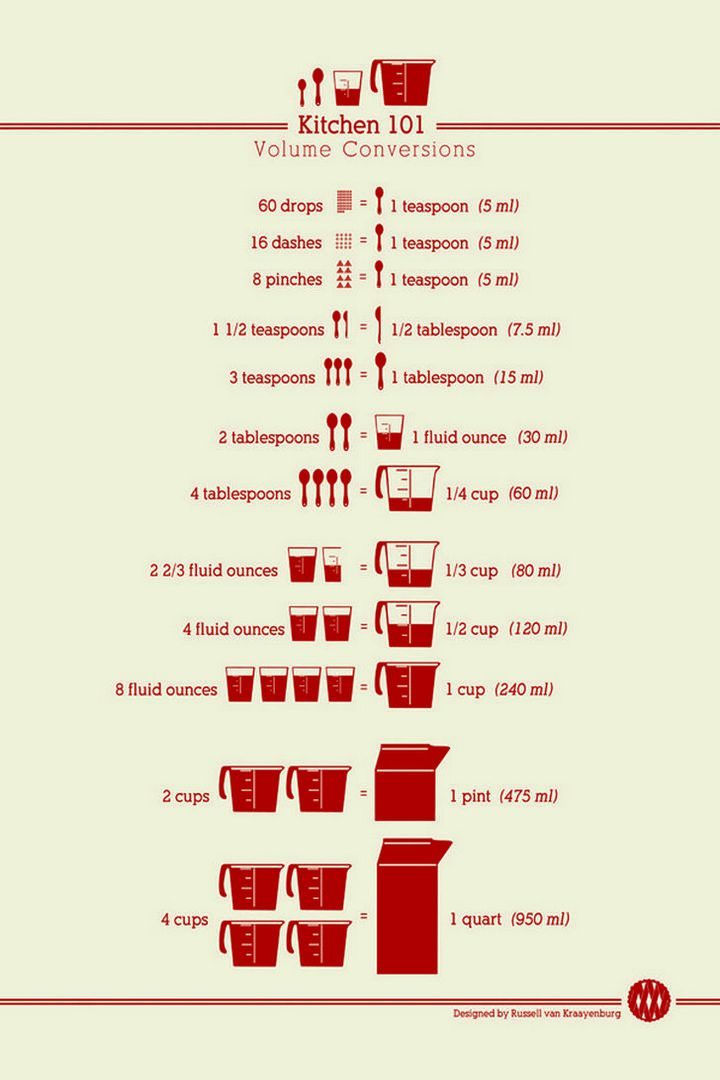
Kitchen volume conversions:
- 60 drops = 1 teaspoon (5 ml)
- 16 dashes = 1 teaspoon (5 ml)
- 8 pinches = 1 teaspoon (5 ml)
- 1 1/2 teaspoons = 1/2 tablespoon (7.5 ml)
- 3 teaspoons = 1 tablespoon (15 ml)
- 2 tablespoons = 1 fluid ounce (30 ml)
- 4 tablespoons = 1/4 cup (60 ml)
- 2 2/3 fluid ounces = 1/3 cup (80 ml)
- 4 fluid ounces = 1/2 cup (120 ml)
- 8 fluid ounces = 1 cup (240 ml)
- 2 cups = 1 pint (475 ml)
- 4 cups = 1 quart (950 ml)
13) How to perfectly cook grains.
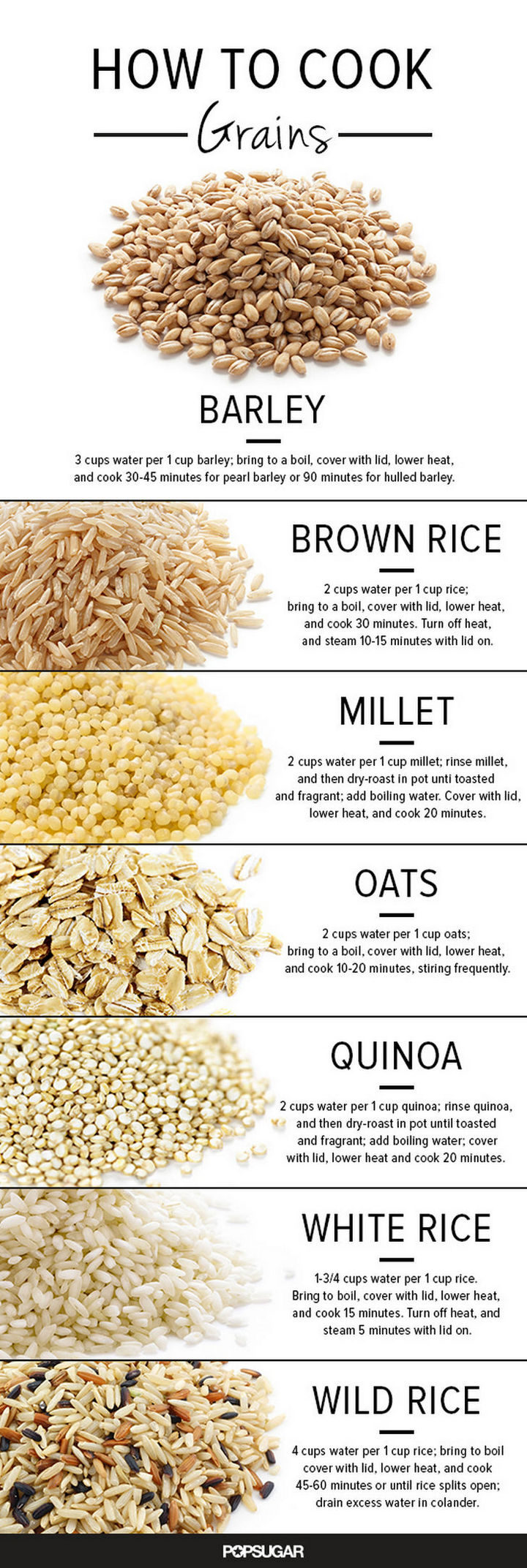
How to cook grains:
- Barley: 3 cups of water per 1 cup of barley. Bring to a boil, cover with lid, lower heat, and cook for 30-45 minutes for pearl barley or 90 minutes for hulled barley.
- Brown rice: 2 cups of water per 1 cup of rice. Bring to a boil, cover with lid, lower heat and cook for 30 minutes. Turn off heat, and steam 10-15 minutes with lid on.
- Millet: 2 cups of water per 1 cup of millet. Rince millet, and then dry-roast in pot until toasted and fragrant. Add boiling water. Cover with a lid, lower heat, and cook 20 minutes.
- Oats: 2 cups of water per 1 cup of oats. Bring to a boil, cover with lid, lower heat, and cook 10-20 minutes, stirring frequently.
- Quinoa: 2 cups of water per 1 cup of quinoa. Rinse quinoa, and then dry-roast in pot until toasted and fragrant. Add boiling water, cover with lid, lower heat, and cook 20 minutes.
- White rice: 1 3/4 cups of water per 1 cup of rice. Bring to a boil, cover with lid, lower heat, and cook 15 minutes. Turn off heat, and steam 5 minutes with lid on.
- Wild rice: 4 cups of water per 1 cup of rice. Bring to a boil, cover with lid, lower heat, and cook 45-60 minutes or until rice splits open. Drain excess water in colander.
14) How to know what foods to keep and what to toss with these kitchen tips.
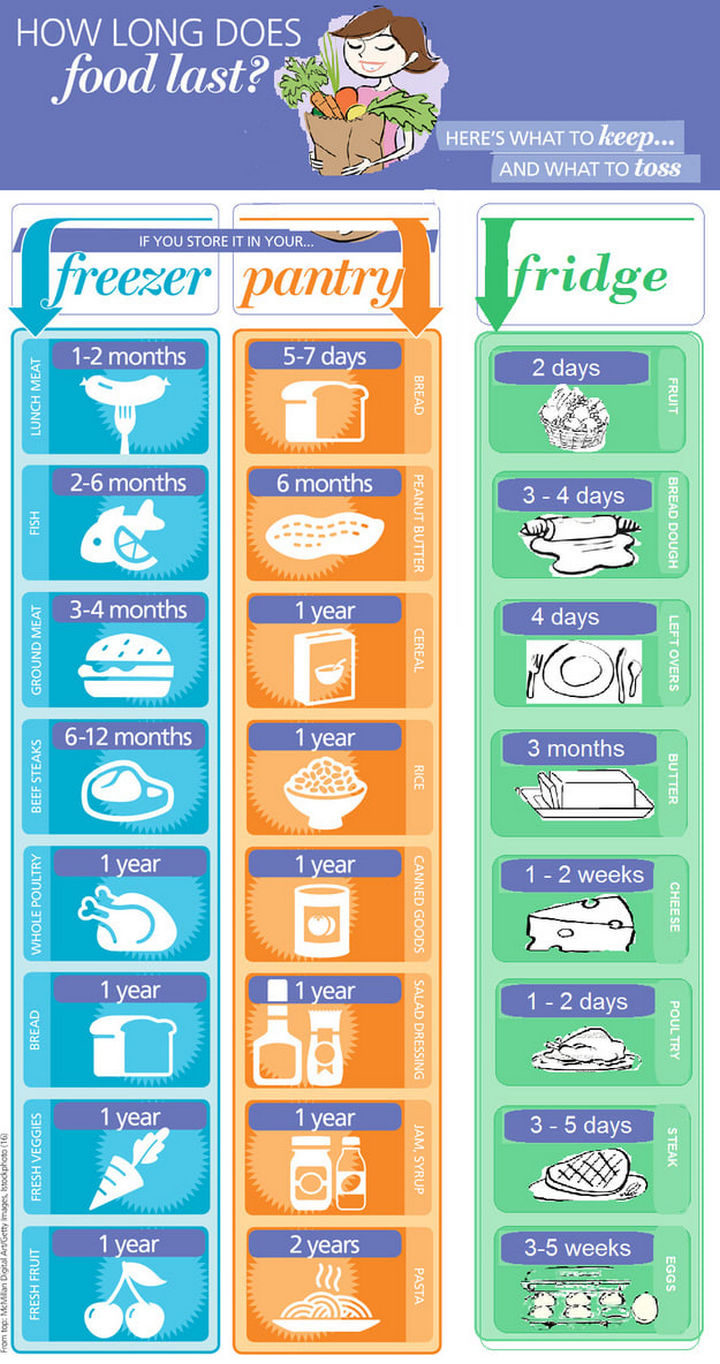
How long does food last? Here is what to keep and what to toss!
If you store these foods in your freezer:
- Lunch meat can last for 1-2 months.
- Fish can last for 2-6 months.
- Ground meat can last for 3-4 months.
- Beef steaks can last for 6-12 months.
- Whole poultry, bread, fresh veggies, and fresh fruit can last up to a year.
If you store these foods in your pantry:
- Bread can last 5-7 days.
- Peanut butter can last for up to 6 months.
- Cereal, rice, canned goods, salad dressing, and jam or syrup can last up to a year.
- Dried pasta can last up to 2 years.
If you store these foods in the fridge:
- Fruit stays fresh for 2 days.
- Bread dough stays fresh for 3-4 days.
- Leftovers stay fresh for up to 4 days.
- Butter stays fresh for up to 3 months.
- Cheese stays fresh for 1-2 weeks.
- Poultry stays fresh for 1-2 days.
- Steak stays fresh for 3-5 days.
- Eggs stay fresh for 3-5 weeks.
15) Kitchen tips for how to convert oven or stovetop cooking time to slow cooking time.
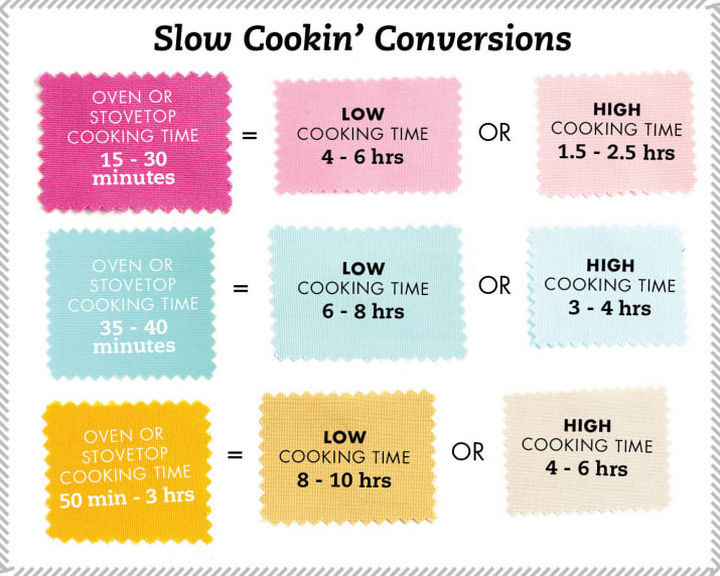
Any oven or stovetop recipe can be cooked in a slow cooker if you convert it properly. Here are slow cooker conversions:
- 15-30 minutes oven or stovetop cooking time: Cook at low for 4 to 6 hours or at high for 1.5 to 2.5 hours.
- 35-40 minutes oven or stovetop cooking time: Cook at low for 6-8 hours or at high for 3-4 hours.
- 50 minutes to 3 hours oven or stovetop cooking time: Cook at low for 8-10 hours or at high for 4-6 hours.
There are so many other kitchen tips and hacks but hopefully these 15 kitchen tips are a good starting point. If you have a favorite kitchen or cooking tip, let us know in the comments!
Please share these helpful kitchen tips and cheat sheets with your friends and family.

